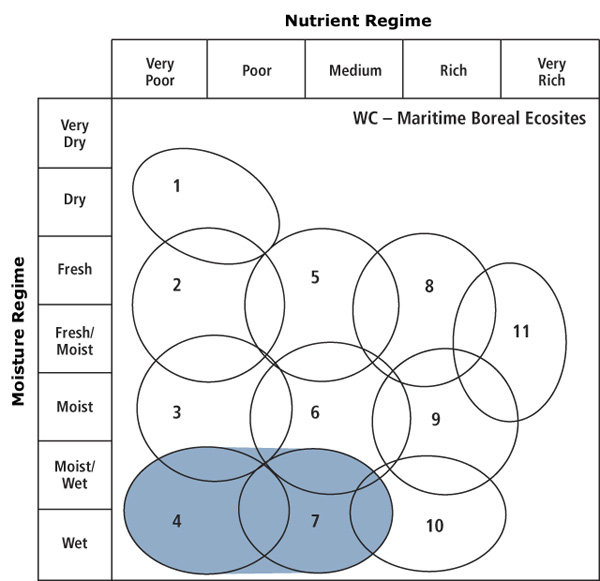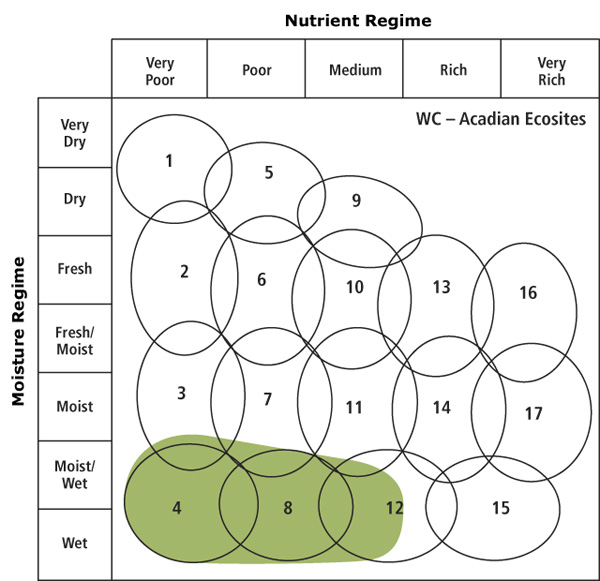
Wet Coniferous Forest Group (n=177)
WC1 — Black spruce / Cinnamon fern / Sphagnum (n=65)
WC2 — Black spruce / Lambkill – Labrador tea / Sphagnum (n=39)
WC2a — Huckleberry – Inkberry variant
WC3 — Jack pine – Black spruce / Rhodora / Sphagnum (n=9)
WC3a — Black spruce variant
WC4— Red pine – Black spruce / Huckleberry – Rhodora / Sphagnum (n=3)
WC5 — Red spruce – Balsam fir / Cinnamon fern / Sphagnum (n=19)
WC6 — Balsam fir / Cinnamon fern – Three seeded sedge / Sphagnum (n=18)
WC7 — Tamarack – Black spruce / Lambkill / Sphagnum (n=17)
WC7a — Huckleberry – Inkberry variant
WC8 — Hemlock / Cinnamon fern – Sensitive fern / Sphagnum (n=7)
Concept: These are wet forest ecosystems with water at or near the surface for most of the year. They are generally dominated by softwood species such as black spruce, tamarack and balsam fir with an understory of plants tolerant of wet, acidic (nutrient poor) soils. They usually occur on moderately exposed, level to depressional topography with soils derived from either mineral or organic parent material. All Vegetation Types (VT) are found in the Acadian Ecosite group, with black spruce dominated VTs also found in the Maritime Boreal Ecosite group.
Vegetation: Crown closure can be moderate to high in VTs of this group, but some stands only support widely spaced trees. Black spruce is the main overstory species, with other VTs distinguished by tamarack, jack pine, red pine, balsam fir, red spruce and/or hemlock cover. The shrub layer is usually well developed with ericaceous species, false holly and winterberry. Characteristic herbs include cinnamon fern, creeping snowberry and several sedge species. Sphagnum moss coverage is generally extensive.
Environmental Setting: Vegetation types in this group are found on upper and lower flats, lower and toe positions of gentle slopes, shallow depressions and riparian zones. Most sites have little (if any) exposed bedrock, but surface stoniness can be variable. Soils are generally derived from glacial till and/or organic deposits. Fertility is generally low except where nutrient availability is enhanced by ground water or seepage inputs. Rooting depth is strongly limited by high water levels. VTs can form small to large patches (and sometimes matrix forests) on the landscape. This group is found throughout the province, but is prominent in the Northumberland Bras d'Or Lowlands (500), Valley and Central Lowlands (600) and Atlantic Coastal ecoregions as well as the Sable (760) ecodistrict.
Successional Dynamics: These wet coniferous forests are mainly edaphic climax communities limited by excessive moisture and low fertility. Fluctuating water levels, windthrow, insects and disease are significant disturbance agents. Stands within a given VT may display a range of development stages depending on disturbance history and natural senescence.

Ecological Features: These small to large patch forests usually develop on wet organic or mineral soils, but are occasionally found on moist upland sites. Wet coniferous forests receive water from precipitation, springs, seepage or surface flows. Water flows and nutrient inputs in this group are lower than those in wet deciduous forests, while peat accumulation is generally higher. These forests make important contributions to landscape diversity, carbon and water budgets. They can provide habitat for numerous plants, lichens, invertebrates and vertebrates (including moose, spruce grouse, rusty blackbird, swamp and Lincoln's sparrows, wood turtle and several amphibians). Edaphic climax forests in this group are self sustaining, and many express long term ecological continuity and old growth characteristics. Wetter stands may persist as woodlands, with stunted and widely spaced trees.
| 1a. Tamarack abundant to dominant | WC7 Tamarack – Black spruce / Lambkill / Sphagnum | |
| 1b. Tamarack absent to scattered | 2 | |
| 2a. Black spruce and/or pines abundant to dominant | 3 | |
| 2b. Black spruce and/or pines absent to scattered | 7 |
|
| 3a. Pines absent or sparse | 4 | |
| 3b. Pines scattered to dominant | 6 | |
| 4a. Shrub layer cover exceeds herb layer cover | 5 | |
| 4b. Herb layer cover exceeds shrub layer cover | WC1 Black spruce / Cinnamon fern / Sphagnum | |
| 5a. Shrubs primarily ericaceous species | WC2 Black spruce / Lambkill – Labrador tea / Sphagnum | |
| 5b. Shrubs primarily non-ericaceous species | SP7 Black spruce / False holly / Ladies' tresses sphagnum |
|
| 6a. Jack pine and black spruce dominant | WC3 Jack pine – Black spruce / Rhodora / Sphagnum | |
| 6b. Red pine and black spruce dominant | WC4 Red pine – Black spruce / Huckleberry – Rhodora / Sphagnum |
|
| 7a. Red spruce abundant to dominant | WC5 Red spruce – Balsam fir / Cinnamon fern / Sphagnum | |
| 7b. Red spruce absent to scattered | 8 | |
| 8a. Balsam fir abundant to dominant | WC6 Balsam fir / Cinnamon fern – Three seeded sedge / Sphagnum |
|
| 8b. Hemlock abundant to dominant | WC8 Hemlock / Cinnamon fern – Sensitive fern / Sphagnum | |
